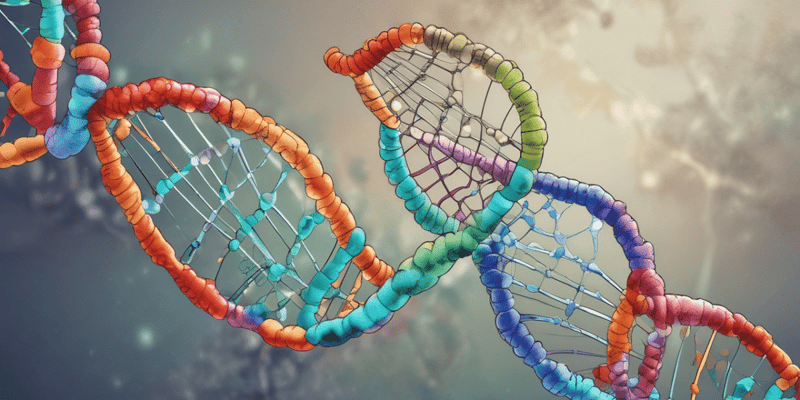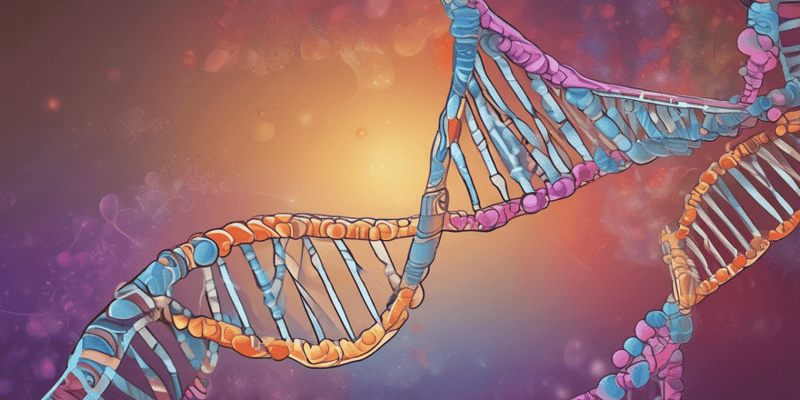39 Questions
What is the term for the moving DNA segments that McClintock discovered?
Transposons
What was the prevailing view of chromosomal DNA among scientists in the 1950s?
It was very stable and changed only through recombination
When did McClintock's ideas about transposons begin to gain acceptance?
In the late 1970s, after transposons were discovered in other organisms
What is the term for genetic changes that occur due to an influence outside of a cell?
Induced mutations
What is the purpose of using mutagens in genetic research?
To increase the mutation rate in bacteria, making mutants easier to find
What type of mutations can chemical mutagens cause?
Both base substitutions and frameshift mutations
What is the term for an agent that induces genetic changes?
Mutagen
What is the result of homologous recombination in DNA?
The recipient DNA is replaced, and the DNA it replaced is degraded.
What is the function of DNA gyrase and helicases at the origin of replication?
To break and unwind the DNA helix
In which direction do DNA polymerases synthesize DNA?
5' to 3' direction
What is the purpose of adding DNase to the medium in DNA-mediated transformation?
To inhibit the uptake of DNA by recipient cells.
What is the role of RNA primers in DNA replication?
To provide a template for DNA synthesis
What is the source of naked DNA in DNA-mediated transformation?
Cells that have burst or secreted some DNA.
What is required for DNA to be maintained in a population?
The DNA must be part of a replicon.
Why can't DNA polymerases initiate DNA synthesis?
Because they require RNA primers
What determines the specific nucleotides that are added to the new strand?
The base pairing rules
What is the necessary condition for transformation to occur?
The recipient cell must be in a state of competence.
Which of the following is true about competent bacteria?
They take up DNA regardless of its source.
What is the function of replisomes in DNA replication?
To coordinate the action of many different enzymes
What is the purpose of characteristic nucleotide sequences in the genome of competent bacteria?
To recognize DNA from closely related bacteria.
What is the consequence of a molecule lacking an origin of replication?
It will not be replicated
What is the purpose of the high-energy phosphate bond in DNA synthesis?
To provide energy for the reaction
What is the control mechanism for competence in some prokaryotic species?
The process is tightly controlled by population density and nutrient availability.
What happens to the reading frame when a nucleotide pair is added to the DNA?
The reading frame is shifted
What is the result of a transposon jumping into a gene?
The gene is insertionally inactivated
What is the effect of a transposon on downstream genes in the same operon?
Their expression is stopped
Who conducted classic studies on transposition?
Dr. Barbara McClintock
What was the focus of Dr. Barbara McClintock's studies?
Colour variation in corn kernels
What was the result of a deletion of a single nucleotide pair in the DNA?
A frameshift mutation
Where was Dr. Barbara McClintock's laboratory located?
Cold Spring Harbor, New York
What were Dr. Barbara McClintock's key tools in her research?
Curiosity and determination
What is the result of an error during excision in Hfr cells?
Removal of a chromosomal fragment along with the F plasmid DNA
What is the mobile gene pool composed of?
Genes that can move from one DNA molecule to another
What is the function of the origin of replication in plasmids?
To allow for independent replication of the plasmid
What is the difference between the genes in the core genome and the mobile gene pool?
The core genome is composed of conserved genes, while the mobile gene pool is composed of genes that vary among strains
What is the result of the transfer of an F' plasmid to an F- cell?
The F- cell receives a chromosomal fragment from the F' plasmid
What is the characteristic of the genes in the mobile gene pool?
They can move from one DNA molecule to another
What is the purpose of the F plasmid?
To facilitate the transfer of genetic material between cells
What is the significance of the core genome and mobile gene pool?
They demonstrate the surprising variation in the gene pool of a single species
Study Notes
Initiation of DNA Replication
- Bacterial chromosomes and plasmids have one origin of replication, whereas archaeal and eukaryotic chromosomes have multiple sites.
- A molecule lacking this sequence will not be replicated.
Process of DNA Replication
- The process requires the coordinated action of many enzymes and proteins, including DNA polymerases, helicases, and primases.
- DNA polymerases synthesize DNA in the 5' to 3' direction, using one parent strand as a template.
- Primases synthesize short stretches of RNA complementary to the exposed templates.
- RNA primers are required at the origin of replication.
Process of DNA Synthesis
- DNA polymerase adds nucleotides onto the 3' end of the new strand, powering the reaction with the energy released from high-energy phosphate bonds.
- DNA polymerases add nucleotides only onto an existing nucleotide strand, so they cannot initiate synthesis.
Frameshift Mutation
- The addition of a nucleotide pair to the DNA results in a shift in the reading frame when the sequence is transcribed and translated.
- Deletion of a single nucleotide pair in the DNA would have a similar effect.
Transposons (Jumping Genes)
- Transposons are pieces of DNA that can move from one location to another in a cell's genome.
- The gene into which a transposon jumps is insertionally inactivated, meaning that the inserted DNA disrupts the function of the gene.
- Most transposons contain transcriptional terminators, which stop the expression of downstream genes in the same operon.
Barbara McClintock's Discoveries
- Barbara McClintock discovered transposons and their role in colour variation in corn kernels.
- She observed that the kernel colours were not inherited in a predictable manner and concluded that segments of DNA were moving into and out of genes involved in kernel colour.
Induced Mutations
- Induced mutations are genetic changes that occur due to an influence outside of a cell, such as exposure to a chemical or radiation.
- Chemical mutagens can cause base substitutions or frameshift mutations.
Homologous Recombination
- The molecular mechanisms involved in homologous recombination are still not fully understood.
- Donor DNA replaces a homologous segment of recipient DNA, and the DNA it replaced is degraded.
DNA-Mediated Transformation
- DNA-mediated transformation involves the uptake of "naked" DNA by recipient cells.
- Naked DNA is free in the cells' surroundings and is not contained within a cell or a virus.
- The process requires competence, a specific physiological state that allows the cell to take up DNA.
F' Donors
- Hfr strains can revert to F+ because the process of F plasmid integration is reversible.
- F' plasmids are formed when an error occurs during excision, and a piece of the bacterial chromosome is removed along with the F plasmid DNA.
The Mobile Gene Pool
- The mobile gene pool refers to the genes that vary considerably among different strains of a species.
- These genes can move from one DNA molecule to another, carried on mobile genetic elements including plasmids, transposons, genomic islands, and phage DNA.
The Core Genome
- The core genome refers to the genes that are conserved between strains of a species.
- The genes in the core genome vastly outnumber the sequences in the mobile gene pool.
Plasmids
- Plasmids are common in the microbial world and are found in many bacteria, archaea, and some eukarya.
- Plasmids are double-stranded DNA molecules with an origin of replication and can be replicated independently of the chromosome before the cell divides.
Learn about the initiation of DNA replication, including the role of DNA gyrase, helicases, and primases. Discover how the origin of replication sequence is essential for DNA replication.
Make Your Own Quizzes and Flashcards
Convert your notes into interactive study material.
Get started for free



